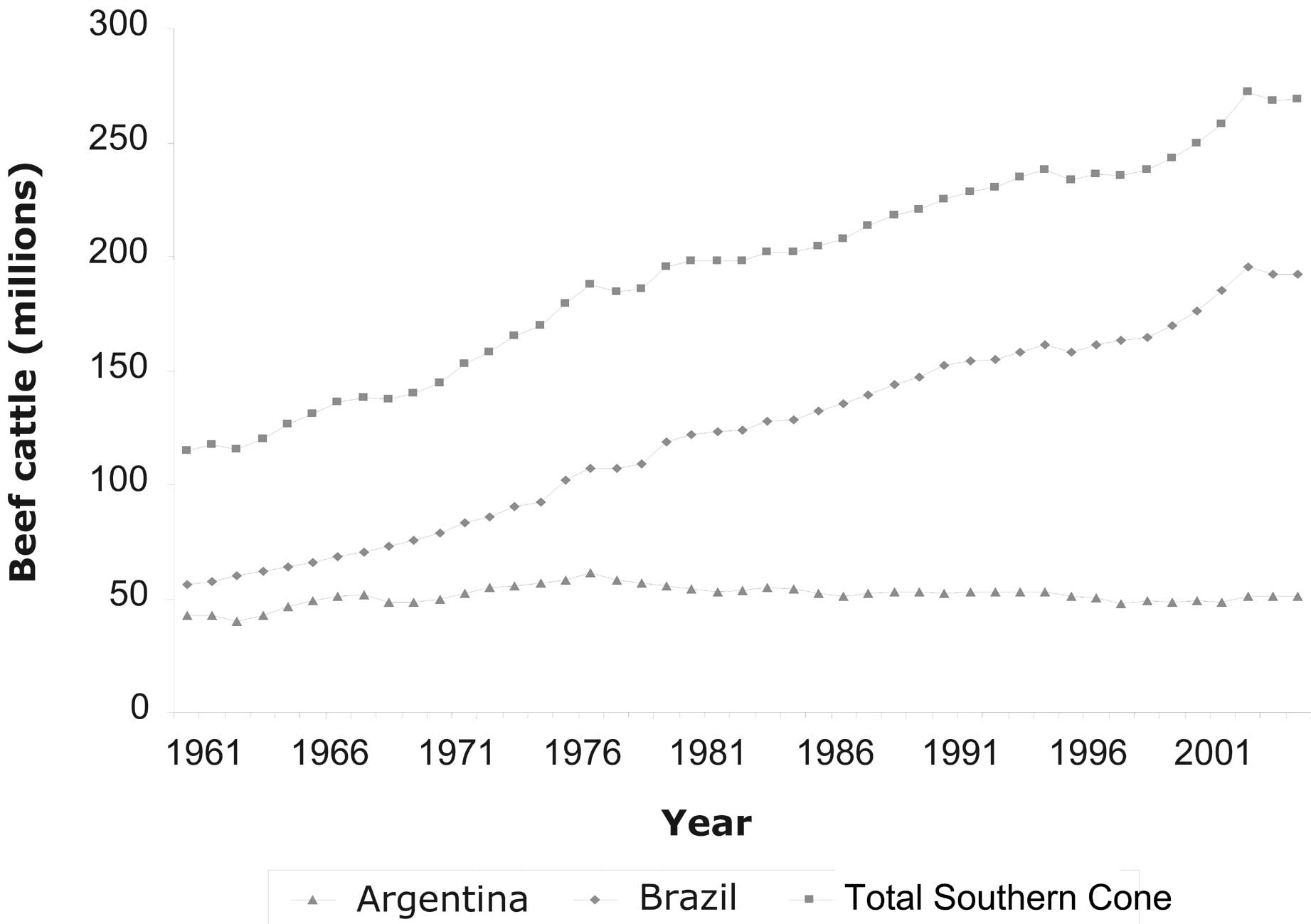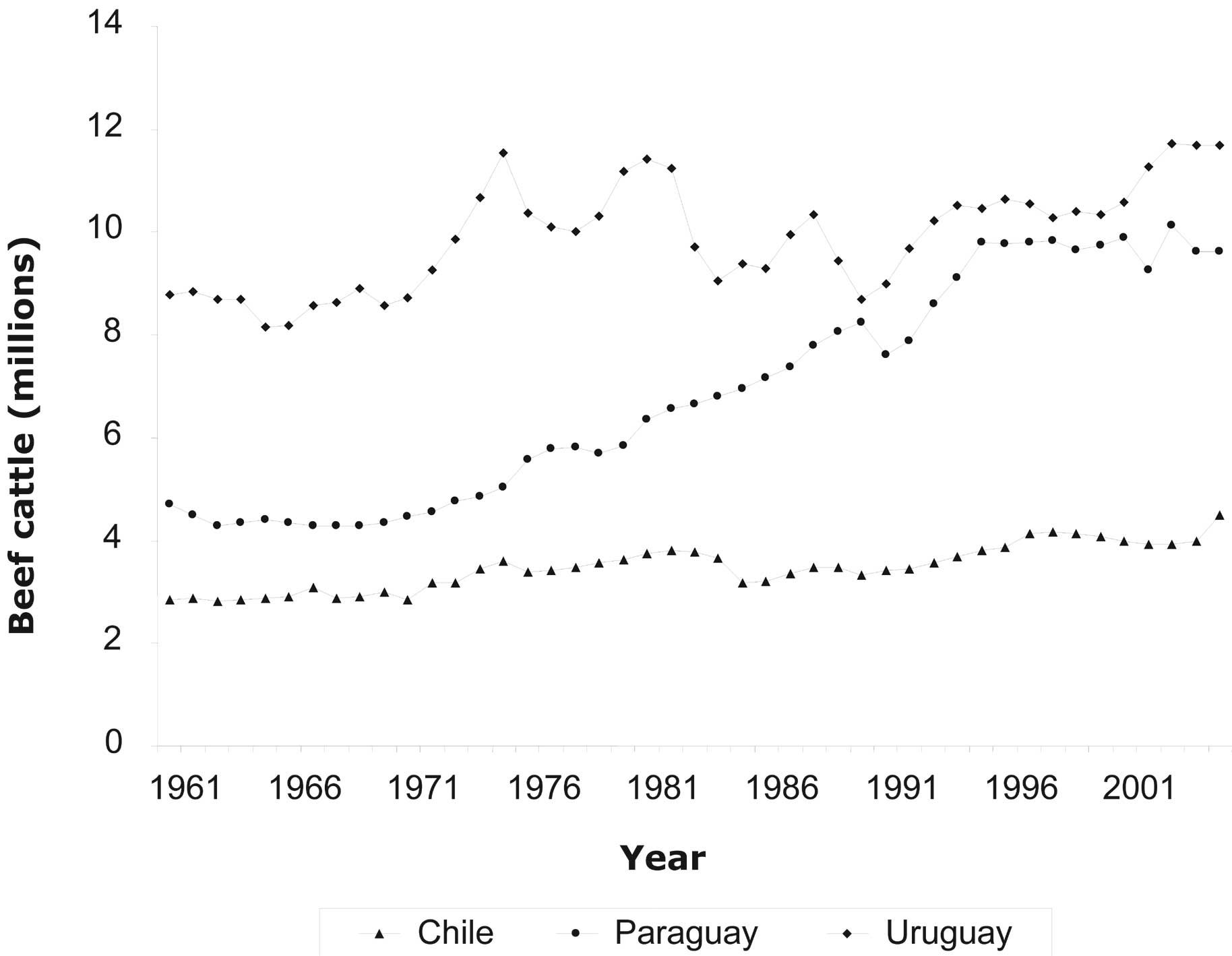

Figure 1-8. Evolution of the number of beef cattle in Southern Cone countries. Source: Authors’ elaboration from FAOSTAT data.
tively significant increases (from 15 to 28%). One of the
main trends in the English-speaking Caribbean has been the
conversion of agricultural lands to urban centers and activities
for tourism. Box 1-8 discusses this situation in several
countries of this region.
The four subregions of LAC also differ in terms of the percentage of land that is under different uses (for example, permanent crops and pasturelands, among others). As reflected in Table 1-8, Central America (including Mexico) and the Caribbean are the two regions with the highest proportion of their territory in seasonal crops. This is related to greater population density and the predominance of the maize and bean system in Central America and sugarcane in the Caribbean. Compared to the other regions, the Caribbean also has a higher proportion of land in permanent crops. The proportion of land in pastures in the Caribbean, the Andean region and the Southern Cone fluctuates from 25 to 27%, but Mesoamerica has a higher proportion of its land in pastures (almost 40%). Finally, both the Southern Cone and the
Andean region have more than 50% of their territory under forest cover, while the Caribbean and Mesoamerica have a smaller percentage (20 and 30% respectively).
In terms of products or specific groups of categories of products, there have been changes depending on the markets demands. In some products, growth has been minimal and there has even been stagnation, such as root crops and tubers, coffee, bananas, cotton and cereal grains. In contrast, there has been a jump in the production of oil-bearing crops (mainly soybean and African palm), fruits, vegetables and sugarcane.5
Recently sugarcane has taken on great importance given
its potential for the production of ethanol. Sugarcane has
the advantage of being quite efficient in the production of
biomass and is a crop that can produce year-round. In the
region, only Brazil has begun to make significant use of sugarcane
as a raw material in the ethanol industry (Dias de
Oliveira et al., 2005; Licht, 2005). It is argued that Brazil
has the potential to produce enough ethanol to respond to
the domestic demand for fuel if it earmarks all of its cane
production to the production of ethanol, or if the area given
over to this crop is doubled (in other words, if the area increases
to 5.6 million ha) (Berg, 2004). Unfortunately, expanding
the area of this crop has negative implications for
the environment. It is estimated that sugarcane monoculture
accounts for 13% of all herbicide use in all Brazil. Studies
done by EMBRAPA in 2002 (cited by Altieri and Bravo,
2007) confirm the contamination of the Guaraní aquifer in
the state of Sao Paulo, which is attributable mainly to the
cane crop (Altieri and Bravo, 2007). The area planted in
sugarcane is quickly expanding to the Cerrado region, one
of the biodiversity hotspots (Myers et al., 2000) and is contributing
to the destruction of this unique ecosystem, which
maintains only 20% of its original vegetation (Mittermejer
et al., 2000).
In addition to soybean, another oil-bearing crop that has
expanded considerably in the region has been African oil palm,
which has undergone expansion mainly in Central America,
Ecuador and Colombia (Carrere, 2001; Buitrón, 2002; Donald,
2004). As in the case of soybean, the expansion of this
crop, which is produced on large expanses as a monoculture,
is threatening unique ecosystems such as the tropical
forest of the Chocó in Ecuador and Colombia (Fearnside,
2001b; Donald, 2004). In Colombia, there have also been
cases of violent displacements of Afrodescendant communities
to grow African palm (Diocese of Quibdó, 2001).
The production of cereal grains (beans, lentils, pigeon
peas and others) and root crops and tubers has remained
stable in recent years, but in some cases there have been
drops in production. LAC exported a total of 18.8 million
tonnes of cereal grains (18% of world exports) (USDA,
2005), but almost all of this was produced by Brazil and
Argentina (4 million tonnes and 14.5 million tonnes respectively).
In the particular case of maize, world exports come
to 74.5 million tonnes, of which only 14 million are exports
from LAC, specifically Argentina, Brazil and Mexico.
The maize crop and its consumption in Mexico and Central
America have been affected by imports of subsidized maize
_____________
5 Rural Development Unit of CEPAL, based on the FAO production yearbook, Rome.